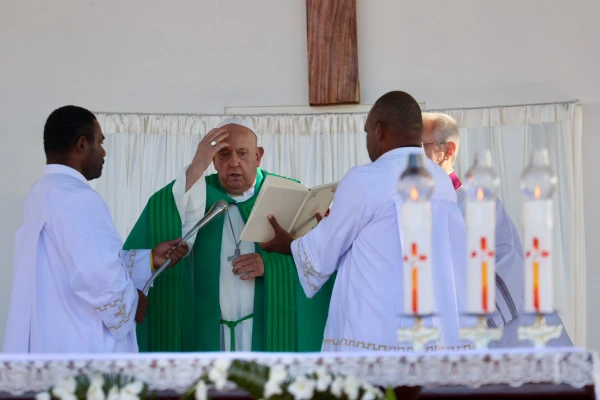Port Moresby, Papua New Guinea, Sep 8, 2024 / 00:01 am
During Pope Francis’ apostolic journey to Papua New Guinea, the pope reflected on the profound sacrifices made by early Catholic missionaries and martyrs in the region who ventured deep into the unexplored rainforests to bring the Gospel to “the ends of the earth.”
Speaking to Catholics from across the island gathered at the Shrine of Mary Help of Christians in Port Moresby, the pope honored the enduring legacy of those who brought Christianity to the Pacific island.
“Missionaries arrived in this country at the middle of the 19th century, and the first steps of their ministry were not easy. Indeed some attempts failed. However, they did not give up,” Francis said.
“With great faith, apostolic zeal, and many sacrifices, they continued to preach the Gospel and serve their brothers and sisters, starting again many times whenever they failed,” he said, highlighting how missionaries, through their “starts” and “restarts,” courageously laid the foundation for the Catholic Church in Papua New Guinea.
Christianity was introduced to Papua New Guinea by Marist missionaries who arrived on Woodlark Island in 1847 only to be forced to withdraw the following year. They were followed five years later by missionaries from the Pontifical Institute of Foreign Missions, but they, too, were forced to leave after three years of work on the island. The first Mass would be offered in Papua New Guinea more than 30 years later on July 4, 1885, by French missionaries on Yule Island.
The legacy of these missionaries includes both those who made the ultimate sacrifice for their faith and those whose lives of heroic virtue are being recognized through the Church’s beatification process.
During World War II, 197 Roman Catholics were executed during the Japanese invasion of Papua New Guinea in 1942 and 1943, according to researchers at the University of Papua New Guinea.
The brutal occupation saw many lives lost, including those of missionaries who steadfastly upheld their faith in the face of oppression. The leading candidate for Papua New Guinea’s first native saint was among those martyred during the Japanese occupation.
Here is a closer look at three remarkable individuals who shaped the Catholic mission in Papua New Guinea:
Blessed Giovanni Battista Mazzucconi (Italy)
Father Giovanni Battista Mazzucconi, an Italian missionary, was one of the early martyrs of the Catholic Church in Papua New Guinea.
Born on March 1, 1826, in Italy, Mazzucconi was ordained in May 1850 and joined the Pontifical Institute for Foreign Missions.
He arrived in Australia in March 1852 before embarking on his mission to Woodlark Island in Milne Bay Province. Despite his efforts to immerse himself in the local culture and his initial struggles with illness, Mazzucconi remained dedicated to his mission. Tragically, on Sept. 7, 1855, he was ambushed and killed by locals while attempting to continue his work. He was beatified in 1984 for being killed “in odium fidei” (in hatred of the faith), and his canonization awaits the confirmation of a miracle.
Pope Francis encouraged devotion to Mazzucconi when speaking to the roughly 35,000 Catholics gathered for his stadium Mass in Port Moresby.

“May Blessed John Mazzucconi accompany you on this journey, for amid much difficulty and hostility he brought Christ into your midst, so that no one would remain deaf before the joyful message of salvation and that all might loosen their tongues to sing of God’s love. May this indeed be so for you today,” the pope said.
(Story continues below)
Blessed Peter To Rot (Papua New Guinea)
Blessed Peter To Rot, a native of New Britain province in Papua New Guinea, is celebrated for his steadfast faith and bravery in standing up for the truths of Church teaching.
Born in 1912, To Rot served as a catechist in his village, taking on the responsibility of catechizing after the local priest was taken by the Japanese army. During the Japanese occupation, which imposed strict laws against religious practice, To Rot was a fierce defender of Christian values, including the sanctity of marriage. His refusal to comply with Japanese rules restricting religious practice led to his arrest and imprisonment in a manual labor camp.
In 1945, he was executed by lethal injection. Beatified in 1995 by Pope John Paul II, To Rot’s legacy is a testament to his purity of faith and his commitment to his community under dire circumstances.
In Pope Francis’ meeting with Catholics in the remote Diocese of Vanimo on Papua New Guinea’s northern coast, the pope recalled To Rot’s “witness to love.”
“Blessed Peter To Rot, spouse, father, catechist, and martyr of this land gave witness to love by word and example. He gave his life precisely to defend the unity of the family in the face of those who wanted to undermine its foundations,” the pope said.
Venerable Bishop Alain de Boismenu (France)
Bishop Alain Marie Guynot de Boismenu, born on Dec. 27, 1870, in France, is remembered as a pivotal figure in the Catholic Church’s mission in Papua New Guinea.
Ordained a priest and a member of the Missionaries of the Sacred Heart, Boismenu arrived in Papua New Guinea in 1897. He was appointed apostolic vicar of Papua in 1908, a role he held until his retirement in 1945.
During his tenure, he significantly expanded the Church’s reach, establishing new missions, schools, and training centers for catechists. He also founded the Handmaids of the Lord, a religious congregation for women.
Although he is not a martyr, the beatification process for Boismenu based on his heroic virtues was initiated in 1984, and he was declared Venerable by Pope Francis in 2014. His dedication to pastoral care and education left an indelible mark on the region.







